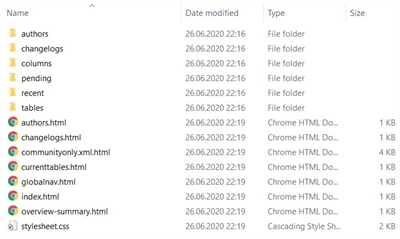db-doc
The db-doc command generates documentation in a Javadoc format based on the existing database and changelogs.
Uses
The db-doc command is typically used to generate database documentation with the change information stored in the changelogs and the existing database. It captures the current state of your database including everything that has been performed against it.
The image below shows an example of the database documentation.

Note: See the changelogDocs.zip file for an example of the database documentation structure with the related directories and files.
Syntax
To run the db-doc command, specify the driver, classpath, and URL in your Liquibase properties file. For more information, see Create and Configure a liquibase.properties File. You can also specify these properties from the command line.
Then run the db-doc command:
liquibase db-doc --output-directory=exampleDirectory --changelog-file=example-changelog.xmlNote: The --output-directory=exampleDirectory syntax was added in Liquibase 4.4. If you use an older version, specify your output directory as a positional argument: <command> exampleDirectory. It is best practice to specify a new empty directory because the db-doc command creates its own directories, the CSS file, and multiple HTML files.
Command arguments
Tip: For best results, specify all commands and parameters in the --kebab-case format in the CLI. If your preference is camelCase, it also works in the CLI.
| Attribute | Definition | Requirement |
|---|---|---|
--changelog-file
|
The root changelog |
Required |
--url
|
The JDBC database connection URL. See Using JDBC URL in Liquibase. |
Required |
--output-directory
|
The directory where the database documentation is generated. Specify as |
Required |
--default-catalog-name
|
Name of the default catalog to use for the database connection |
Optional |
--default-schema-name
|
Name of the default schema to use for the database connection. If Tip: In Liquibase v4.23.0+, camelCase for Note: The syntax |
Optional |
--driver
|
The JDBC driver class |
Optional |
--driver-properties-file
|
The JDBC driver properties file |
Optional |
--password
|
Password to connect to the target database. Tip: It is a best practice to store sensitive data in a Secrets Management tool with Liquibase Pro. |
Optional |
--username
|
Username to connect to the target database. Tip: It is a best practice to store sensitive data in a Secrets Management tool with Liquibase Pro. |
Optional |
Note: The username and password attributes are not required for connections and systems which use alternate means of authentication. Also, you can specify database credentials as part of the url attribute.
Output
Liquibase command 'db-doc' was executed successfully.